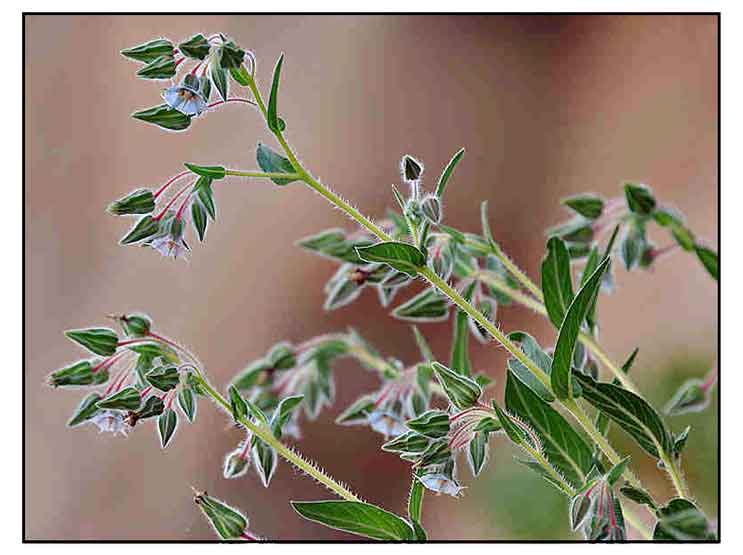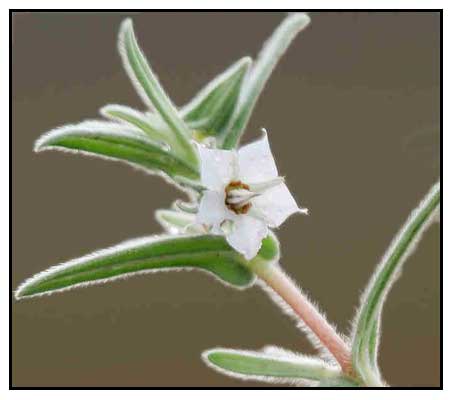 Botany Botany
Trichodesma indicum is an erect, spreading, branched, annual herb, about 50 centimeters in height. Leaves are stalkless, opposite, lanceolate, 2 to 8 centimeters long, pointed at the tip, and heart-shaped at the base; the upper surfaces clothed with stiff hairs arising from circular tubercles, the lower surfaces less densely villous. Flowers occur singly in the axils of the leaves. Calyx is green, hairy, and 1 to 1.3 centimeters long, with pointed lobes. Corolla is pale blue, with the limb about 1.5 centimeters in diameter, and the lobes pointed. Fruit is ellipsoid, and enclosed by the calyx. Nutlets are about 5 millimeters long, and rough on the inner surface.
 Distribution Distribution
- In the Rizal, Quezon and Laguna Provinces in Luzon, as a weed in cultivated grounds, especially in peanut plantations.
- Also occurs in Iran, India, and Mauritius.
Constituents
- Phytochemical screening yielded steroidal, ß-sitosterol and phenolics, catechin and gallic acid. (9)
- Yielded hexacosane, ethyl hexacosanoate and 21,24-hexacosadienoic acid ethyl esters. Seed oil yield oleic, linoleic, palmitic, stearic, and linolenic acid.
(10)
- Phytochemical screening of dried aerial parts yielded ß-sitosterol, gallic acid, and catechin. (see study below)
(13)
- Study of roots yielded n-Decanyl laurate (1), n-tetradecanyl laurate (2), n-nonacosanyl palmitate (3), stigmast-5-en-3β-ol-21(24)-olide (4), n-pentacos-9-one (5), n-dotriacont-9-one-13-ene (6), stigmast-5-en-3β-ol-23-one (7) and lanast-5-en-3β-D-glucopyranosyl-21 (24)-olide (8). (see study below) (14)
Properties
- Acrid and bitter tasting.
- Considered thermogenic, emollient, alexeteric, anodyne, anti-inflammatory, carminative, constipating, diuretic, depurative, ophthalmic, febrifuge and pectoral.
- Flowers considered sudorific and pectoral.
- Leaves considered depurative.
- Studies have suggested anti-inflammatory, analgesic, anticancer properties.
Parts used
Roots, leaves, flowers.
Uses
Edibility
- Leaves and flowers are edible.
Folkloric
- In the Philippines, used in the same manner as Tichodesma zeylanicum.
- Leaves and roots are used as remedy for snake bites;
also used as diuretic.
- Cold infusion of leaves considered depurative.
- Crushed roots, in decoction or infusion, used for dysentery in children.
- In Indian traditional medicine, decoction of roots used for diarrhea, dysentery and fever.
- In Deccan, plants is used as emollient poultice.
- In Chutia Nagpur, roots are crushed and made into a paste, and applied externally to swollen joints, inflammations and superficial skin injuries.
- Used for arthralgias, inflammations, dyspepsia, diarrhea, dysentery, dysmenorrhea.
- In Tamil Nadu, southern India, root decoction taken internally to treat bloody dysentery.
- In Ayurveda, plant used in vitiated condition of Kapha/phlegm and Vata/wind. Root paste applied to wounds.
(16)
- In Easters Ghats, used to treat bone fractures: Poultice of whole plant paste mixed with Albizia amara leaf powder, tumeric powder, goat's milk and wheat is applied on skin around the fractured area and bandaged. (25)
Studies
• Antitussive: Study of methanol extract of the whole plant of Trichodesma indicum on sulfur dioxide-induced cough reflex in Swiss albino mice showed significant inhibition of cough frequency in all tested doses compared with the untreated control group, in an effect comparable to codeine phosphate. (2)
• Anti-inflammatory / Alkane: Study isolated triterpenoids and aliphatic phytoconstituents. Results showed the alkanoic acid significantly inhibited the carrageenan-induced acute arthritis. Alkane, the major phytoconstituent in in vivo studies, suppressed the development of chronic arthritis induced by CFA. (3)
• Anti-diarrheal: Extract study showed significant inhibition of castor oil-induced diarrhea and decreased propulsion of charcoal meal through the GI tract. There was also reduction of castor oil-induced enteropooling. Results support the use of the herbal remedy as a nonspecific treatment for diarrhea in folk medicine. (4)
• Anti-Inflammatory / Roots / Leaves / Flowers: The chloroform extract of T. indicum root exhibited significant anti-inflammatory activity in acute and chronic inflammatory models. (5) Study evaluated various extracts of T. indicum leaves for in vitro and in vivo anti-inflammatory activity. Results showed in vitro anti-inflammatory activity with significant inhibition against lipoxygenase. In in vivo analysis, the methanol extract showed significant inhibition of carrageenan induced rat paw edema. (21) Study of alcoholic and aqueous extracts of flowers showed significant anti-inflammatory activity as evidenced by prevention of hypotonicity induced HRBC membrane lysis. Activity was comparable to standard drug indomethacin. (24)
• Antispasmodic / Lipoxygenase Inhibitory Activity: Study of some Pakistani medicinal plants showed the extract of T. indicum caused reduction in spontaneous and acetylcholine-induced contractions, with 78% inhibition of intestinal contractions and good lipooxygenase inhibitory activity. (6)
• Phytotoxic / Insecticidal: In a study for the agrochemical potentials of ethanolic extracts of selected plants, T. indicum showed excellent herbicidal activity against Lemna minor. It also showed good insecticidal activity against Rhizopertha dominica. (7)
• Antimicrobial: Study evaluated antimicrobial activity of Trichodesma indicum and T. sedgwickianum against bacteria and fungi. The ethanol extract of both species was more active against gram positive bacteria, S. aureus and B. subtilis while the aqueous extract showed strong inhibitory activity against gram negative bacteria like E. coli. (9)
• Antivenom Potential: Study evaluated 29 Pakistani medicinal plants for antivenom potential antivenom potential. T. indicum extract showed restoration against anticoagulation behavior, i.e. decreased anticoagulation from 92% to 20%. (10)
• Corrosion Inhibitor: Study evaluated the corrosion inhibitor effect on C38 steel of an alkaloid extract part of Trichodesma indicum compared with that of imidazole compounds. Results showed the plant extract acted as a better inhibitor in comparison to selected organic inhibitors and suggested a good green inhibitor. (11)
• Antimitotic / Antiproliferative: Study evaluated shoot extracts of dried aerial parts of T. indicum for antimitotic and antiproliferative activities. Both successive cholorofrom and ethanol extracts showed significant antimitotic and antiproliferative activity when compared to standard methotrexate, vincristine, and adriamycin. SEE showed strong inhibition against MCF-7 and MOLT-4 cell lines. (see constituents above)
(13)
• Antimicrobial / Roots: Study evaluated the in vitro antimicrobial potential of ethanol extract of Trichodesma indicum root. Phytochemical analysis of ethanol extract yielded 8 compounds. The ethanol extract and isolated compounds (1-8) showed varying degrees of antimicrobial activities. The EE showed potent growth inhibitory activity against S. aureus, B. subtilis, and C. albicans. Compound 8, lanast-5-en-3β-D-glucopyranosyl-21 (24)-olide, displayed strongest antibacterial activity against S. aureus. (see constituents above) (14)
• Analgesic / Antipyretic / Roots: Study showed the analgesic and antipyretic potential of an ethanol extract of T. indicum using several experimental models, i.e., acetic-induced abdominal constrictions in mouse, tail immersion model, formalin test, and yeast-induced pyrexia. (15)
• Diuretic / Aerial Parts: Study evaluated aerial parts of T. indicum for diuretic activity using the Lipschitz model. Results showed significant diuretic activity with an effect similar to K+ sparing diuretics, together with a saluretic activity. (17)
• Antioxidant / Aerial Parts: Study evaluated leaves (L), fruits (F), and root (R) extracts of Trichodesma indicum and Cleome viscose for phytochemicals and antioxidant potential. Phytochemical screening of T. indicum yielded alkaloids (F,R), polyphenols (F, R, L), and flavonoids (F, R, L). Significant non-enzymatic antioxidant activity was found in both plants. (18)
• Antimicrobial / Anthelmintic / Aerial Parts: Study of ethanolic extract of aerial parts produced significant antibacterial, antifungal, and anthelmintic properties in a dose-dependent manner. Preliminary phytochemical screening yielded alkaloids, steroids, flavonoids, tannins, and phenols. (19)
• Antioxidant /
Antibacterial / Wound Healing / Whole Plant: A methanol extract of whole plant showed good antioxidant activity against nitric oxide scavenging and reducing power assay. An ointment formulation showed good antibacterial activity against tested organisms. On wound healing evaluation, it showed complete rate of contraction (99.63% closure) when compared to Neosporin treated and control base. (20)
• Acute Toxicity Study: Acute toxicity study on four extracts of T. indicum leaves (hexane, acetone, methanol, and aqueous) showed no mortality, signs or toxicity or behavior changes up to 2000 mg/kg body weight. (21)
• Silver Nanoparticles / Antibacterial / Photocatalytic / Leaves: Study reported on the green synthesis of silver nanoparticles using a leaf extract of Trichodesma indicum. The AgNPs showed antibacterial activity against pathogenic B. cereus and E. coli and photocatalytic de-colorization of methylene blue. (22)
• Anti-Diabetic / Leaves: Study evaluated the anti-diabetic activity of T. indicum in in vitro amylase assay and in vivo streptozotocin-nicotinamide induced type 2 diabetic rats. A methanolic leaf extract showed moderate α-amylase inhibitory activity (IC50 of 91.3 µg/ml). The extracts prominently reduced blood glucose levels (p<0.01) in ST-nicotinamide induced diabetic rats comparable to glibenclammide. (23)
Availability
Wild-crafted.
|

![]()





